
22 minute read
Mexico’s Caribbean Coast
FEATURE AND PHOTOGRAPHY FARHAT JAH – WWW.ORIENTAFRICATRAVEL.COM
The Yucatán Peninsula must be the most heavily visited part of Mexico. Planes from around the world land almost continuously at Cancun International Airport. The sandy beaches of the Caribbean are lined with hundreds of large concrete hotels. After a gap of a decade, Farhat Jah went back to a lesser visited village to see what had changed, and to find something new.
Advertisement
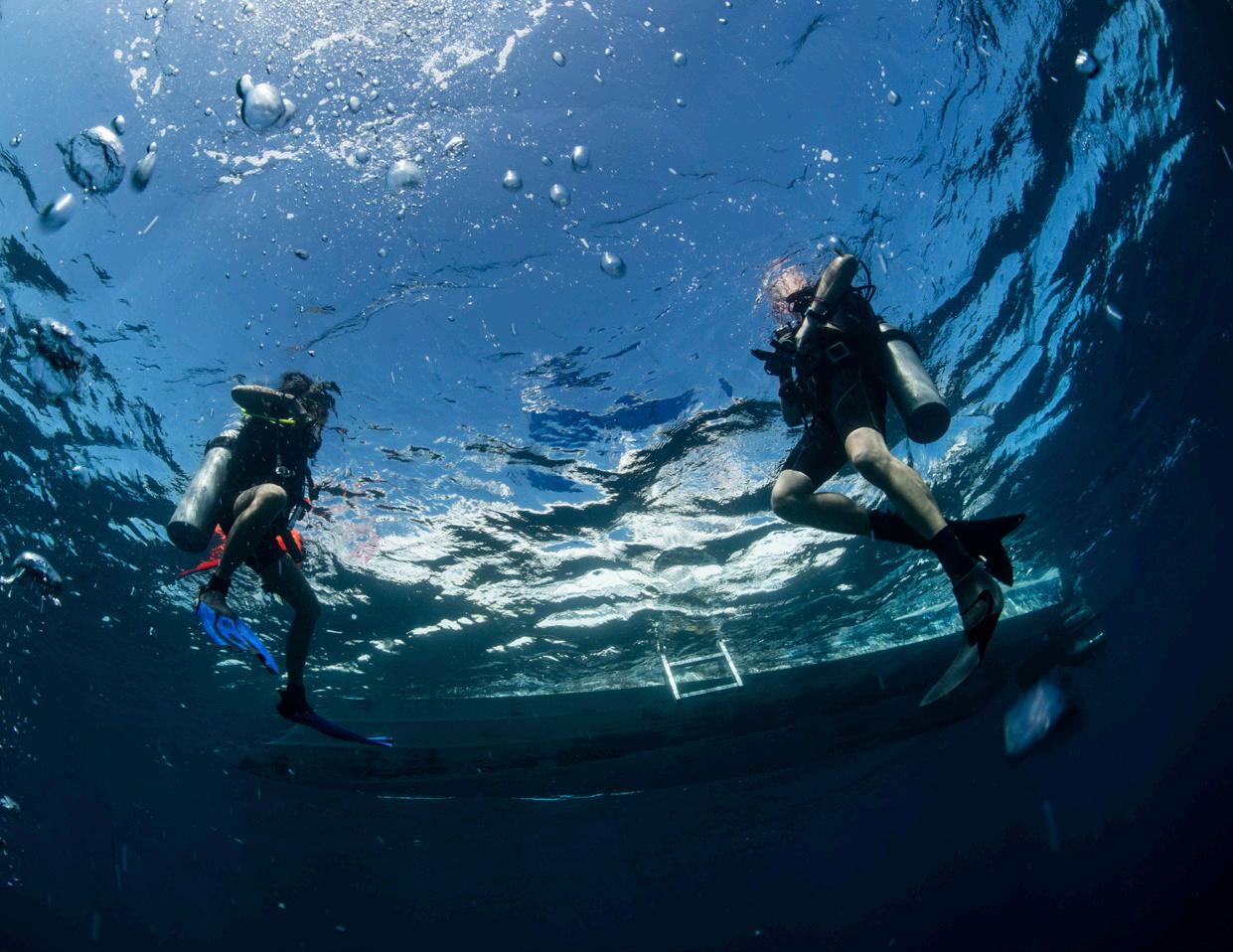
Exiting the water at XTC.
The Yucatán Peninsula is also home to the northern tip of the Meso American reef. Sometimes known as the ‘Belize Barrier Reef’, this is the second largest barrier reef system in the world after the Great Barrier Reef in Australia. Divers come in the hundreds to the island of Cozumel Island and the beach resorts of Playa del Carmen. Nothing I had heard about the Yucatán made me want to visit it. My mind was changed by an American doctor named Mike Alt. 15 years ago, when I lived on a beach in Tanzania, he walked into my Dive Centre and asked if he might dive. Every evening we would sit under the stars with a bottle of red and stare out to sea, where he would tell me about diving the MesoAmerican Reef. He lived in a tiny, very small village, named Xcalak. When he finally left to go back to Mexico, he invited me to visit him.
“Come and see me. I’ll pick you up from Cancun” he said.

Sunrise at XTC Dive Centre.
A year later, after working the annual DEMA Dive show in the USA, Francisca (Cisca) and I made the journey down to Cancun Airport. Mike was as good as his word and collected us at Cancun Airport. After stocking up on what seemed a lot of supplies, we drove for 5.5 hours until we hit Xcalak, the last village in Mexico before reaching the maritime frontier with Belize. Mike lived a simple life. He had a house, a boat, and a crew member. Every day he took us out onto the reef and we would snorkel with eagle rays, tarpon, and jack fish. When we needed to dive, we went to the small but well run diving centre called XTC. Owned by an erudite and enthusiastic Mexican diver named Javier Salas. Every day we jumped onto one of his fibreglass boats, zoomed out through the reef and dropped into the crystal clear water to see tarpon, barracuda and schools of angelfish. It was an idyllic interlude to a stressful life. All too soon, it was time to fly back to Africa, and our journey was at an end. Mike drove us the 5.5 hours back to Cancun, stopping at a few desolate pyramids along the way in the jungle of Muyil. The mosquitos bit us as we staggered around, pushing the creepers away from the path. After a night in a very modest hotel in Cancun, we took a pre-dawn taxi to the airport and took off into the darkness.
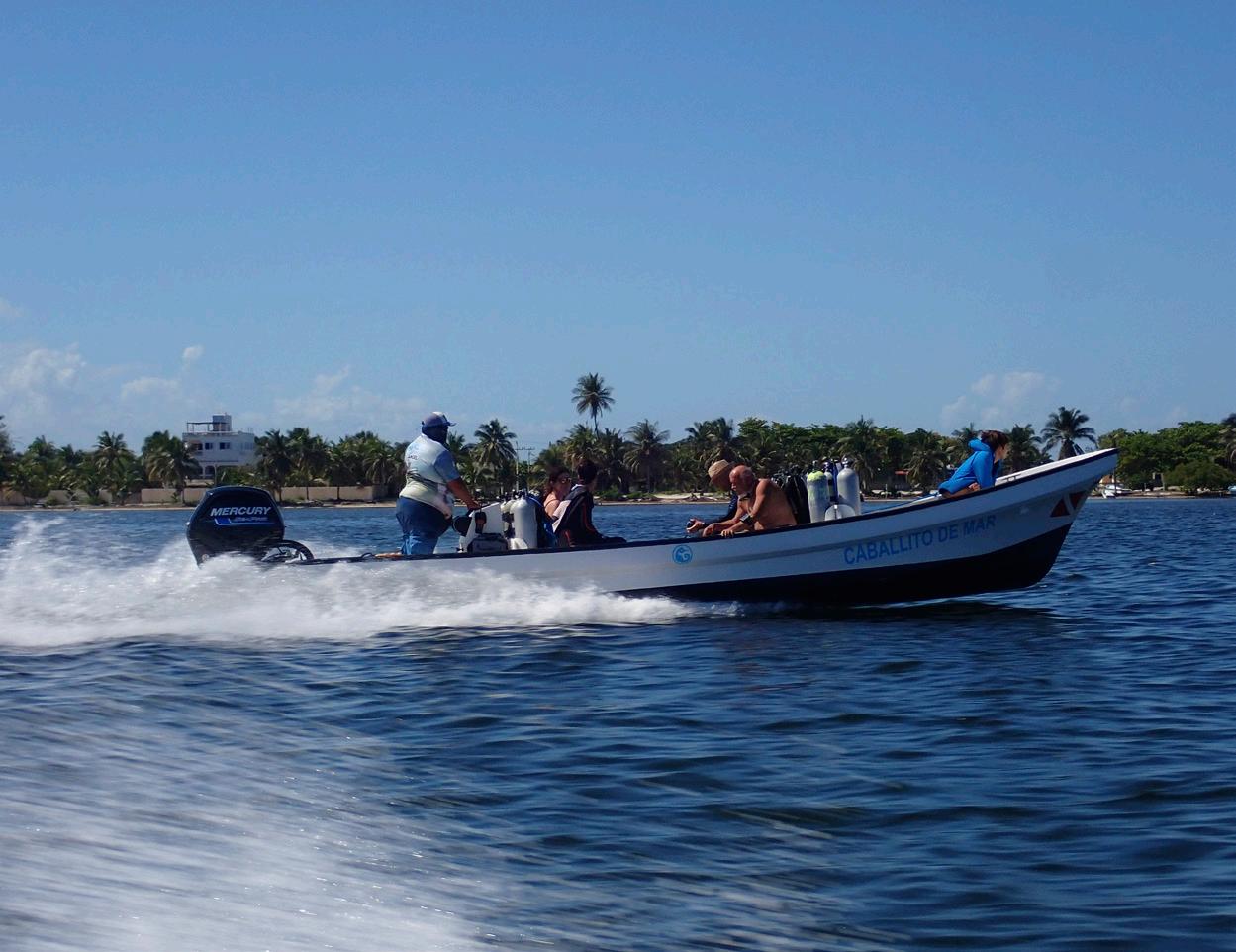
Speeding home back to XTC Dive Centre.
But as life goes: Mike moved away from the village of Xcalak, and we sold our Diving Centre in Africa. As our tour company grew, we found ourselves in New Guinea, Indonesia, St Helena, and the Antarctic. Almost a decade later, in-between dives in Turkey, I was deep in conversation with Paul Bailey (one of our more loyal divers). “I’d like to visit Mexico” he said. “What, with the millions of tourists?” “No, somewhere quiet and perhaps with the chance to see a cenote”. “I’ll have a look”, I told him, and the next tour idea was born.

Sunday afternoon in Xcalak.
THE YUCATÁN REVISITED
It turned out that XTC had survived Covid, albeit in a more slimmed down manner. Javier was as enthusiastic a diver as he had ever been and was ecstatic about our plan. As usual, once I started organising this trip, others wanted to join and pretty soon there were six divers in our group, arriving at Cancun Airport from various parts of the world. The last diver arrived on a British Airways B777 at 5pm and we congregated in a reasonable 3 star hotel in the town of Playa Del Carmen.
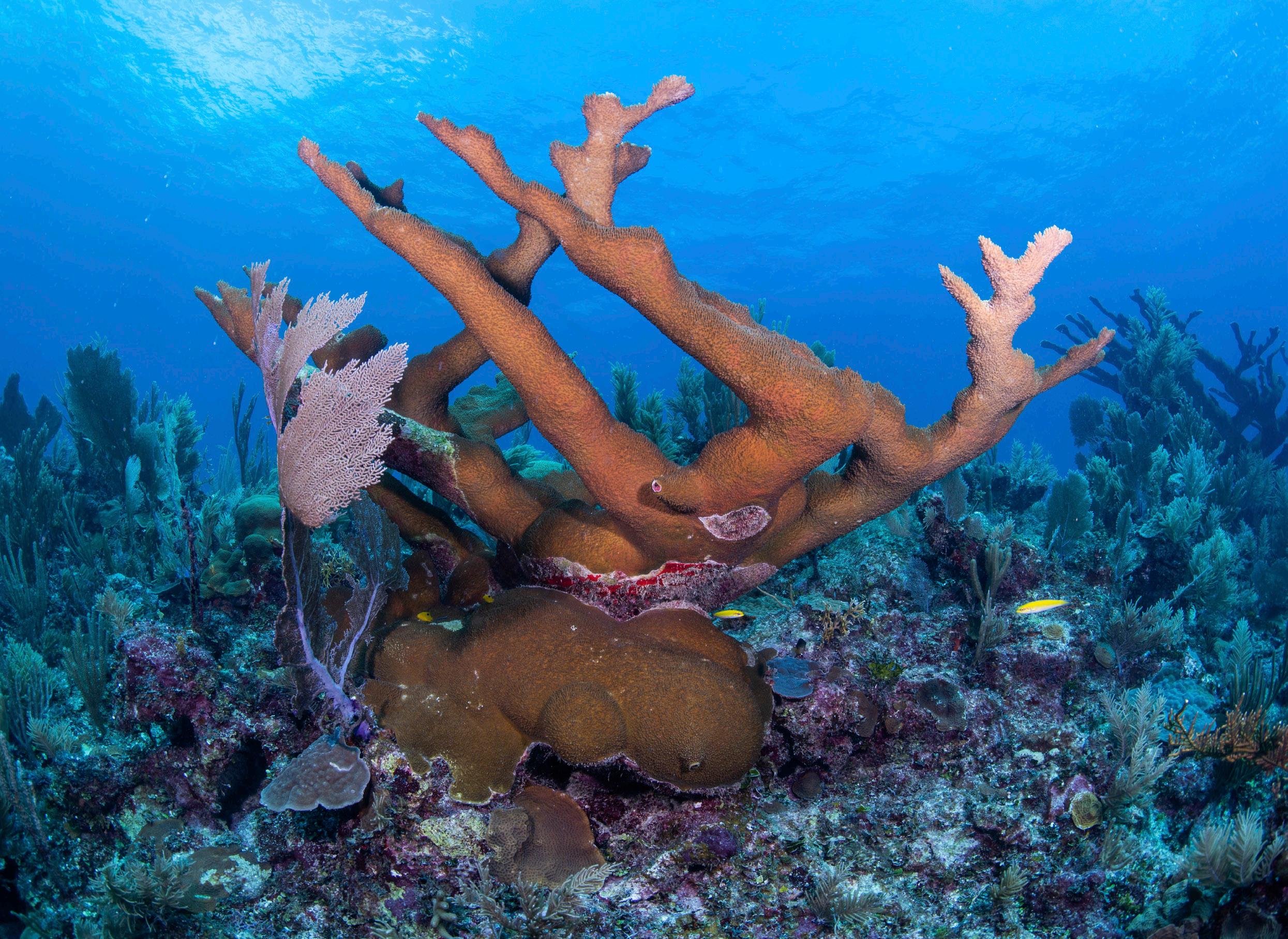
It’s rare to see hard coral in this shape in Xcalak.
The next morning, a comfortable air-conditioned Volkswagen minibus arrived complete with two drivers to take us to Xcalak. As soon as we left Playa we were surrounded by a mass of impenetrable green. The road narrowed soon after we passed the historic pyramids of Tulum. And then pretty soon it was just us on the road, passing through tiny villages with the occasional shop and a cluster of yapping dogs. Luiz, our professional driver, weaved in and out of the articulated lorries going south towards Chiapas and Mexico City.
At the village of Limones, we stopped to stretch our legs. This was where we left the main highway, and headed towards the Caribbean Sea at Mahahual. We then turned south on a new road that was only three decades old and crossed large areas of mangrove swamp while driving on stretches of raised tarmac. This mangrove swamp was what had kept Xcalak so isolated for so many years.
At the southern end of the mangrove swamp, the tarmac ran out. Here, we turned north and crawled over a dusty track. Minutes later we arrived at the XTC Dive Centre. This dive centre was managed by Veronica (Vero), a highly organised instructor from Italy. We unloaded our gear, filled in a few forms and then we had to find our accommodation. Due to an administrative error, our accommodation arrangements were a mess. Single rooms became shared and doubles, and rather than all of us being together in the same place, we were split up. Francisca and I had to stay in a room at XTC Dive Centre, the others in cabins in the village. There was no point in complaining about it, so we agreed to meet later and find somewhere to eat.
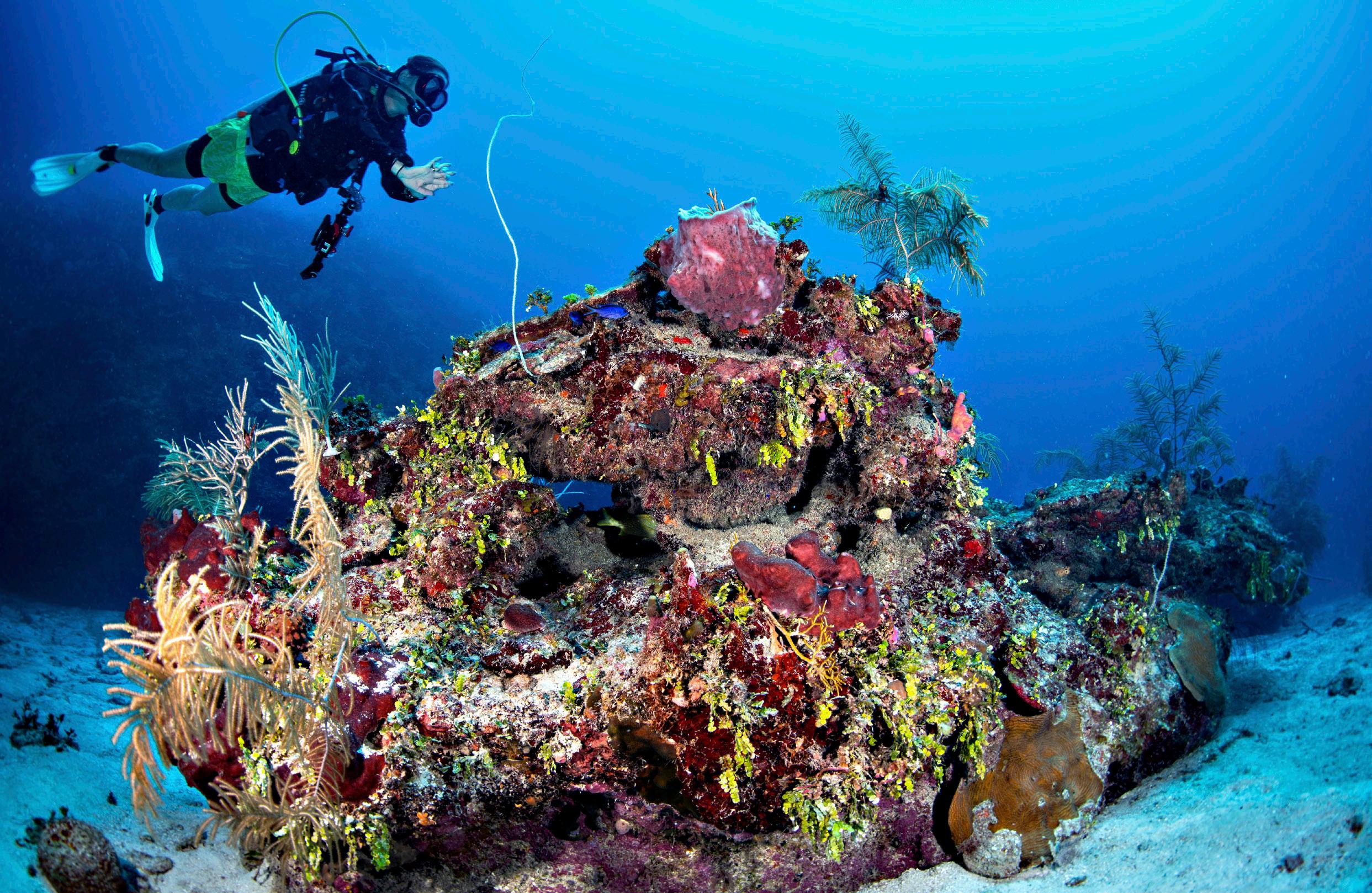
Cisca hovering over the colourful coral reef.
THE VILLAGE OF XCALAK IN 2022
Xcalak had changed very little in a decade. The settlement was made up of a small strip of wooden houses by the sea, many of them on stilts. The reason for this was abundantly clear, above ground level the mosquitoes seemed to dissipate. A couple of kiosks served as shops, and in the centre, people parked their identical white fibreglass boats plying for fly fishing or the snorkelling trade. Who their customers were was a mystery to me as the village was almost empty of tourists.

Angel fish hiding in the coral covered rock.

The reefs are full of lobsters.
There were only three places to eat: Silvia’s restaurant, Costa De Cocos Lodge, and the XTC Café. That first night we tried Silvia’s, which was a very basic affair, a converted house with plastic chairs and tables in a dusty carpark. Every dish cost $10, no matter what was actually in it. I ordered fish tacos and we all had a couple of beers. We sat in the humid still air, waving away the mosquitoes until a child appeared with a pair of coils. The strong poisonous smell wafted around our ankles and the mosquitos instantly decided to move elsewhere. As we walked back through the village to the dive centre, a breeze picked up and we cooled down.
The word Xcalak means “cuts” in Mayan. The barrier reef came close in to the shore and had two channels, or ‘cuts’, that allowed fishermen to access the deep Caribbean Sea without having to go far from shore. Captain Paquero our XTC dive captain, opened up the throttles on the twin outboards and we roared through the gap and out into the Caribbean. We were on our first dive trip of the week. Minutes later, we stopped and Vero gave us the all clear to dive. We dropped into the blue water. The visibility was incredible, and we swam around carefully for somewhere to “land”. The bottom was, I estimated, at 55 metres. So we swam west at 18 metres depth towards land, until at a slightly more comfortable 35 metres we dropped onto the reef. After photographing some of the outer points, we worked our way slowly shallower around enormous barrel sponges. The occasional pompano would come over the top of the reef and look at us warily before swimming away slowly. We were diving on air, and we soon found ourselves having to swim further west “uphill” to avoid decompression. We ended at a relaxed 13 metres, swimming between coral heads. It had been an excellent first dive.
THE MESO AMERICAN REEF WITH BARRACUDAS ON EVERY DIVE
Over the coming days, we were not blessed with good visibility. The wind had picked up and the resulting waves made every site south of Xcalak a little green. The outer walls were better, and the inner shallow reefs were quite sandy. Added to this, the reefs off Mexico were an odd shade of brown and yellow, the only vibrant colour was added by the sponges which were bright yellow or red, but these were generally only visible when reaching deeper than 20m. With only 155 species of fish, it is easy to describe the Caribbean Sea as ‘limited’ – but what makes Xcalak so special is the underwater scenery and the fact that we were subjected to schools of larger fish on every dive. Horse-eye jacks, yellowtail jacks, schools of tarpon, and enormous lobsters were a daily encounter. On the outer reefs, we would often see large potato groupers. Finally, no matter how shallow or deep a dive, we were nearly always guaranteed a visit from a large great barracuda.These fish would come and inspect us. Sometimes they would hang around a metre away, and sometimes they would gently swim away only to return within a few minutes.
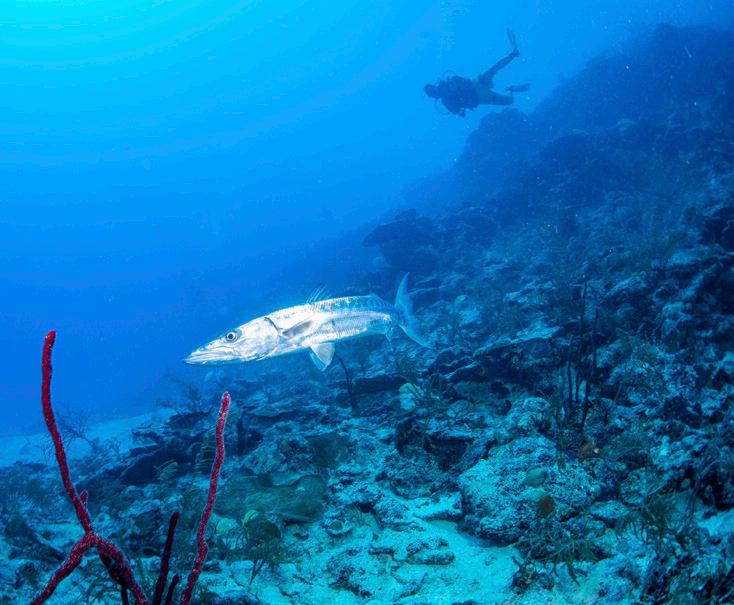
A lone barracuda swimming past.
My favourite dive site was “La Chimenea” or “the chimney”. We sped south towards the border of Belize, and half a mile offshore, opposite the Mexican Naval Station, we rolled in and found the outer reef. After a few metres of swimming south, we came across underwater pinnacles at the mouth of a hidden cavern. We swam around them and entered a main chamber, which Vero called “the cathedral”. The centre had collapsed allowing light to pour in, making it quite eerie. I decided to enter the cavern close to the ceiling at 22 metres and disturbed a small school of rather indignant jackfish. They swirled around me seemingly more annoyed than worried – before tiring and wandering off into the deep.

Looking back into the cathedral.
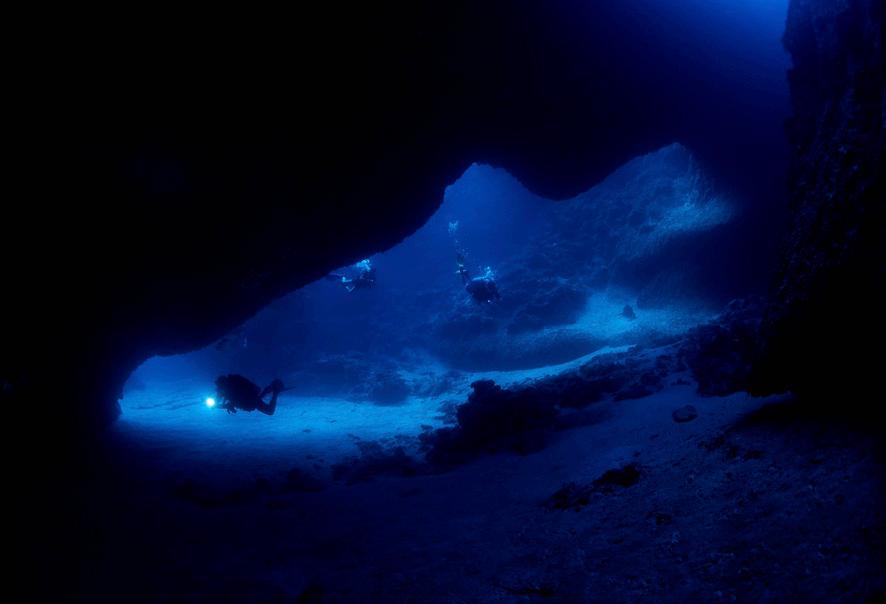
The group enters the cathedral at la chimenea.
Ignoring the departing jacks, I squeezed through under some rocks and found a horizontal passage with light at the back. I gently worked my way into the light which became a 2m wide vertical shaft that led to the surface. I looked back but nobody had followed me, so I turned around and squeezed my way back to “the cathedral”.
Cisca was waiting and after a couple more photographs, we swam out together. We found ourselves on the reef wall at 30 metres. There was no current, I had plenty of air and so we meandered along the reef only to be met by this dive site’s resident great barracuda. This fish swam right up to my lens scaring the living daylights out of me.

Startled horse-eye jacks swim past.
Doing a safety stop on top of the main reef system was a wonderful experience. The soft brown coral waved in the surge as we hung on the SMB line. After a while, we surfaced. Captain Paquero, the ever smiling skipper took our fins and we climbed into the vessel.

The narrow exit from the chimenea.
As soon as the divers were all back, we motored to a Creek that was the mouth of the Bacalar Chico River. This was the border between Belize, and we were searching for Manatees (Trichechus). We chugged gently into the mangroves before switching off and drifting in the muddy water. We were unlucky and ran out of time, but it was a great excuse for some peace and quiet in the green paradise of a mangrove creek. Paquero started the engines and we motored slowly past a wrecked fishing boat, and on towards the mouth of the river. I wanted to lean over and grab a twig to say that I had a Belizean leaf in my hand, but Captain Paquero had sensibly kept us exactly between the two nations.
“La Policea Belize” he said in Spanish. “Problem”.
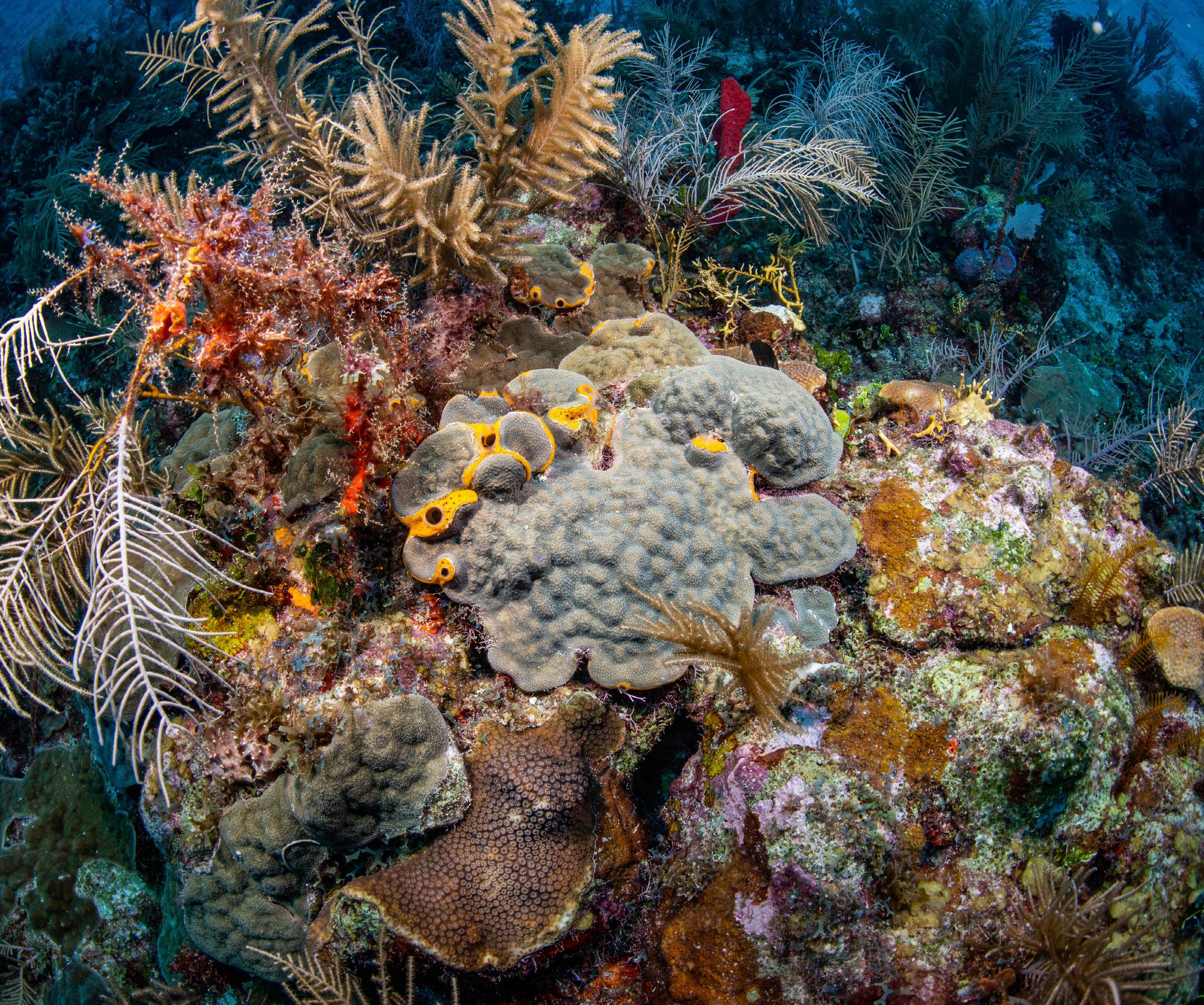
Colour on the reef at Posa Rica.
HOB NA, OUR DEEP AND FINAL DIVE
Vero found us somewhere new to dive everyday. There were finger reefs, steep walls, or a series of long swimthroughs. We sighted nurse sharks, enormous stingrays, and on one occasion we had an eagle ray play with us for about 10 minutes.
On our final day, I askedVero if we might dive the site of Hob Na, located 15km north of the dive centre. This was the northernmost of XTC’s dive sites. It took about 40 minutes to exit the reef, head north and find the dive site. After the previous few days of green 20m visibility, we were once again mesmerised by the crystal clear deep blue water’s of Hob Na. We swam gently as a group towards the Mexican coast until some reef shapes appeared. I pointed to them, and as one, we swam forward and dropped. It would have been easy to hit 70m here, but we stayed at a conservative 34m and hung there. We made our way up to 28m on top of the furthest reef finger.While I was happily photographing an enormous barrel sponge, a rather large nurse shark shot down the narrow channel between the fingers, right under my nose. I snatched a photograph and then she was gone. She had been resting under some rocks and gave us the stinky eye while she leisurely swam off in search of a place to rest.
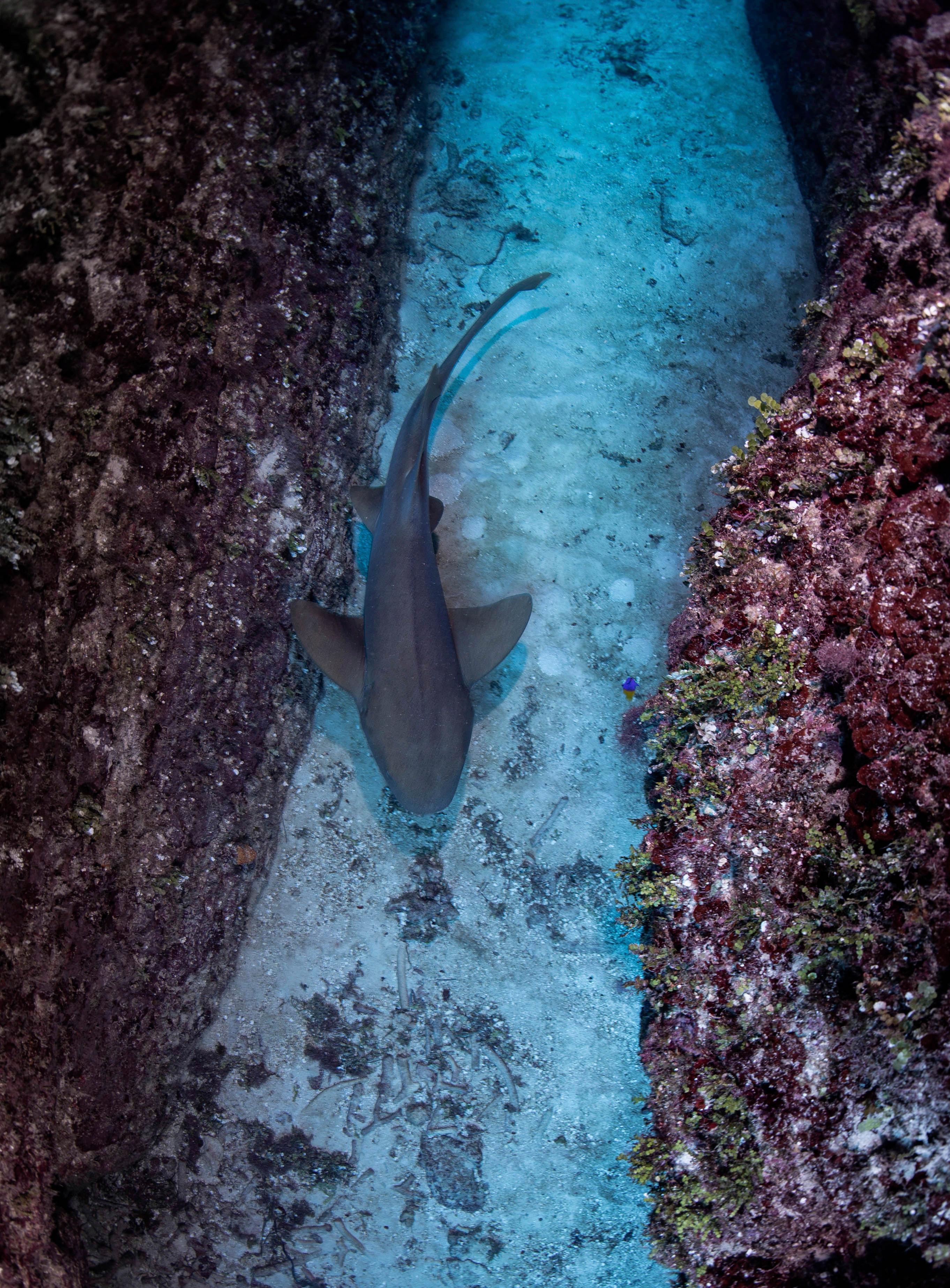
A glimpse of a nurse shark as she passes by along the narrow channel.
The problem with this dive site, was that its most vibrant part was definitely below 25m, where the fish sat in the current. It was also the most colourful and full of sponges. Even by using 32% Nitrox, we ran out of bottom time. We ascended to 16m and ran out of reef, so we ascended to our safety stop and ended the dive.
“Do you want to dive something different?” asked our Captain.
“Sure”, Vero replied. So he drove us to a site 5km south of Hob Na.
“Jump in here”, he said.
It was quite fun to do a dive that none of us had ever done before.
“Same rules as before” Vero said, “we dive a multi level profile”.
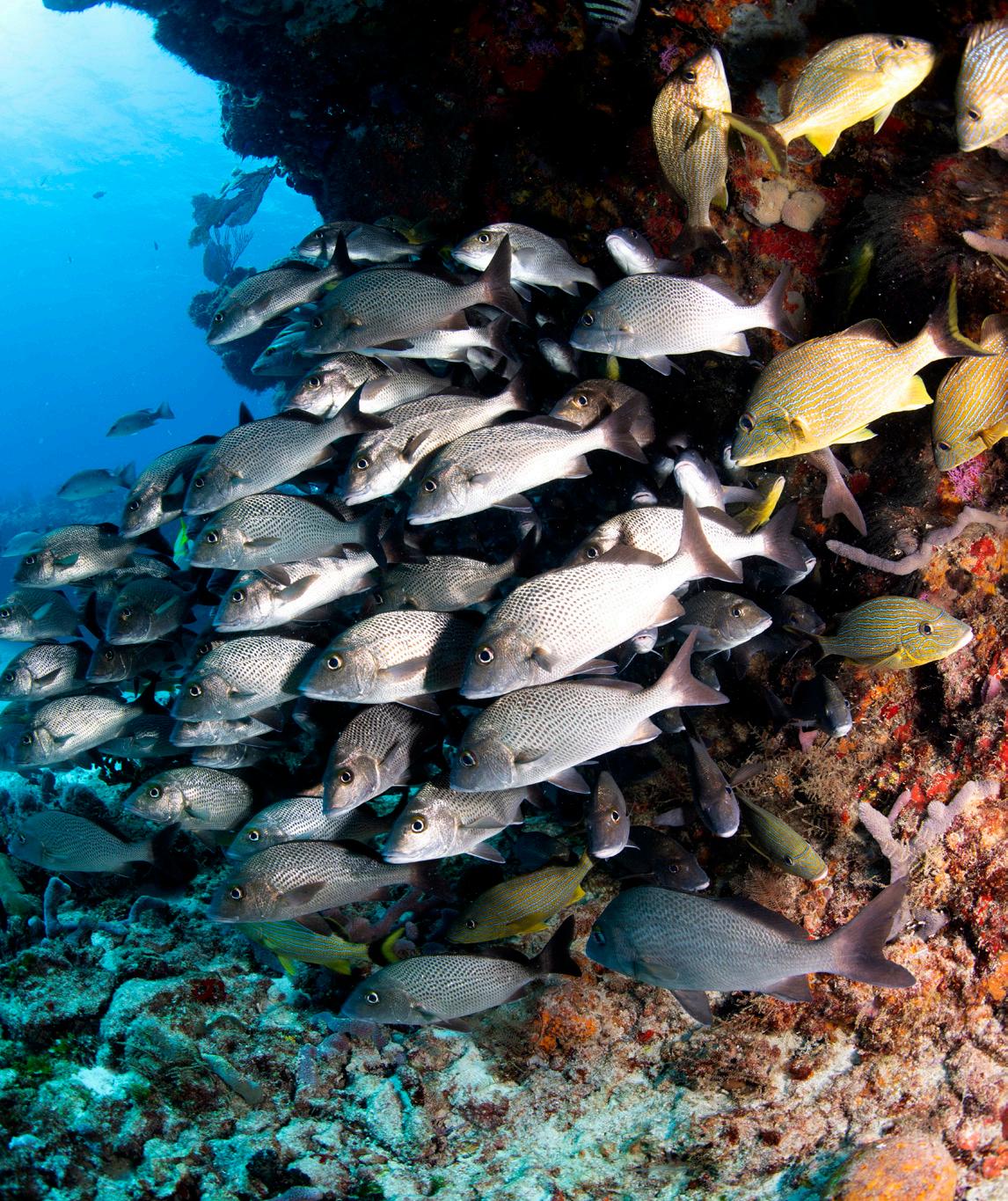
The sea was boiling with fish in every nook and cranny.
We entered the water at Santa Giulia Reef. The dive was similar to Hob Na in that the visibility was excellent. We dived on fingers of reef, hopping from one to another, but the marine life was different in that we had more reef fish.We tried to dive shallow but ran out of reef at 18m and again had to ascend to our safety stop.
After our last dive, we washed our dive gear, hung it up to dry, and had the ubiquitous Margarita in the XTC Café. The strong sun dried our kit very quickly and we packed up for the five hour ride north.
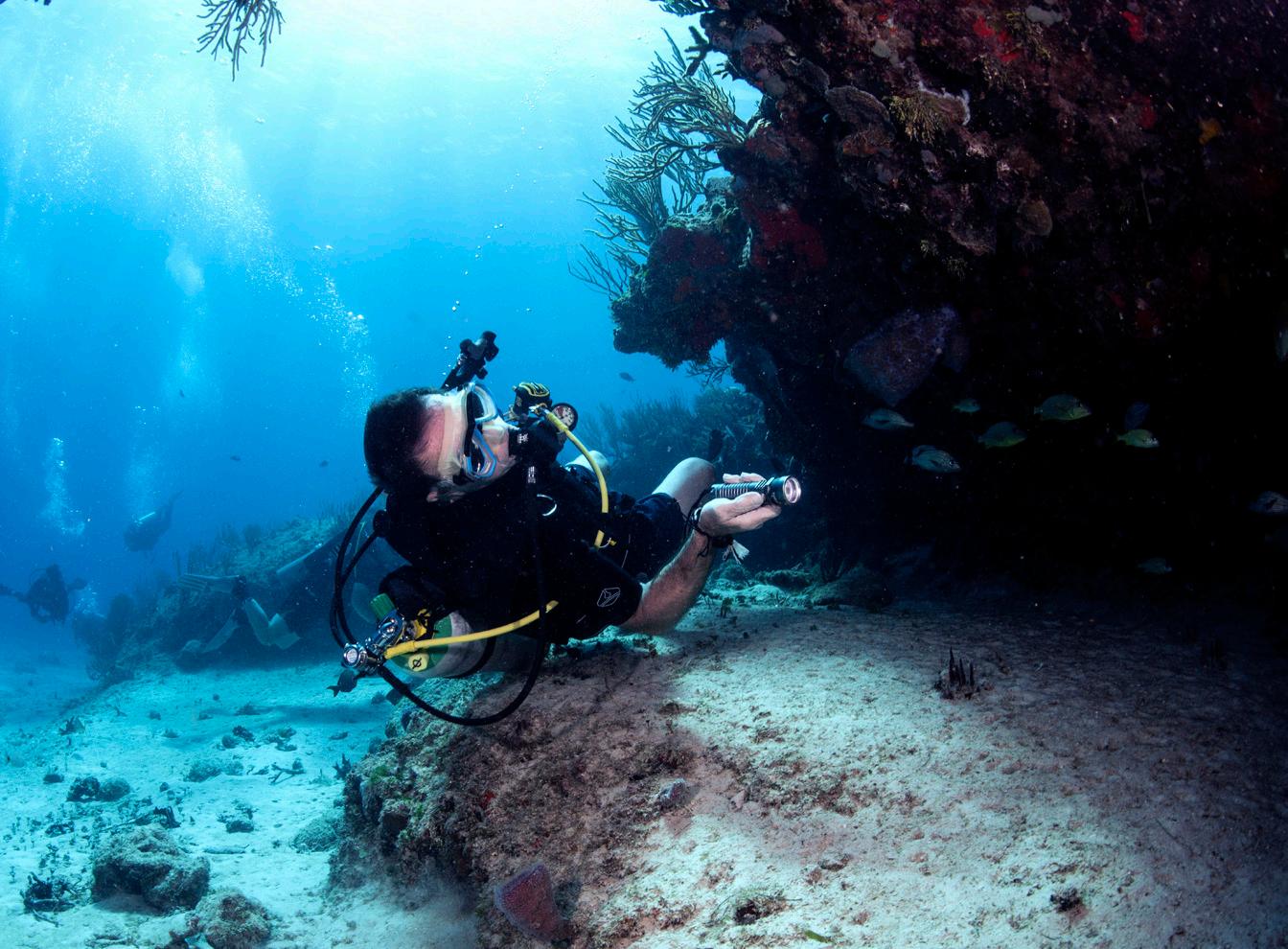
DISTANT BULL SHARKS IN PLAYA
On this occasion, Luiz did not stop. He simply belted north up the highway until the very small settlement of Muyil. I wanted to see the desolate pyramids in the jungle one more time. A decade had changed a lot. Gravel paths cut through the jungle and now linked the small ruins. The good thing was that there were absolutely no mosquitos. What we did see, were the occasional coach load of scantily clad tourists who took photographs of themselves draped over the pyramids, possibly for Instagram?

The pyramid in Muyil.
We carried on to Playa and checked into the same hotel. Here we were in the hands of Paul Flower, the area manager of Dressel Divers. Dressel Divers is an enormous dive factory, churning hundreds of divers into the water all over the Caribbean every day. The difference between Dressel and Vero’s relaxed, but professional style, could not have been more stark. But Dressel Divers worked really well.
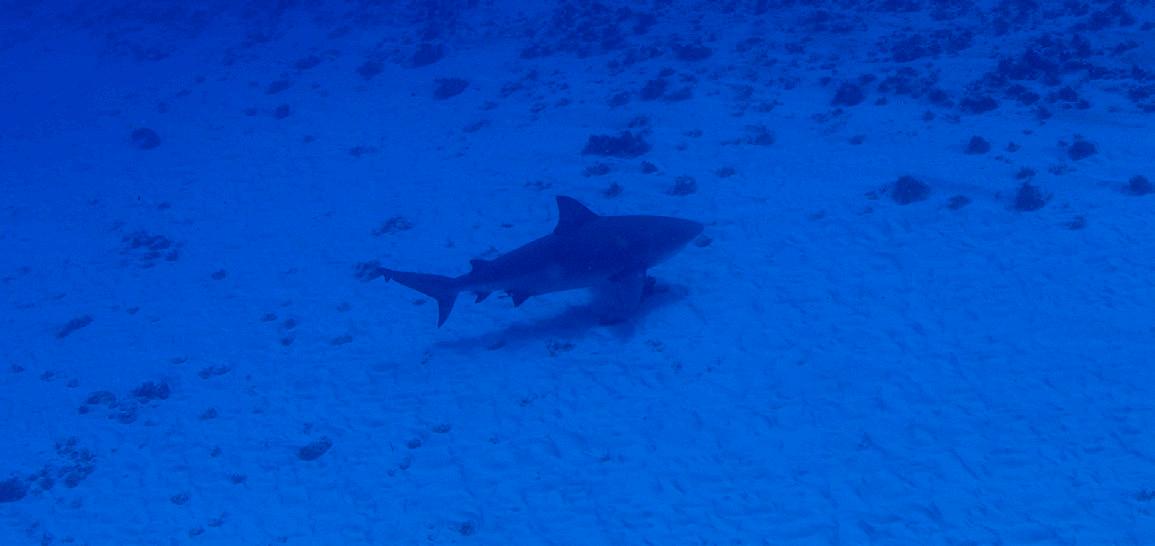
A bull shark seen in the distance.
We turned up, got briefed, and jumped on a trimaran. We motored out in front of the line of deluxe hotels and dropped into the water. It was as clear as Hob Na, but this time we stayed at 22m. We were looking for Bull Sharks. We drifted in a strong current between two deep reefs and kept a look out both left and right. After 10 minutes, a bull shark appeared far below us. 10 minutes later, a much larger example swam lazily over the reef and right underneath us, giving us an excellent if not slightly distant (10m) view of this magnificent creature. Towards the end of the dive, a final shark chased around the top of the reef, but the dark silhouette over dark coral was hard to see. We surfaced completely energised by seeing Bull Sharks for the first time. I was not too disappointed that we had not seen 20 of them.
Our second dive was a 16m sandy reef dive. I expected the worst, but was blown away by the sheer number of snappers and wrasses. Under every overhang, the sea was literally boiling with fish. We did not miss the barracuda of Xcalak as we had so much else to see. I was quite taken aback by how rich the marine life was only a few hundred metres from the bustling town.
FRESH WATER CENOTE DIVING
Our final venture was the dives in the Cenotes in the Yucatán Jungle. We assembled at another Dressel Divers facility and were met by a 6ft 4 German Viking. Olaf Fischer had been a technical cave instructor for Dressel Divers for 13 years. He spoke excellent English and Spanish, as well as his native German. Whatever language he was speaking, he spoke deliberately and quietly. After 5 minutes, it was apparent that he had a very dry sense of humour, and we all warmed to him instantly.
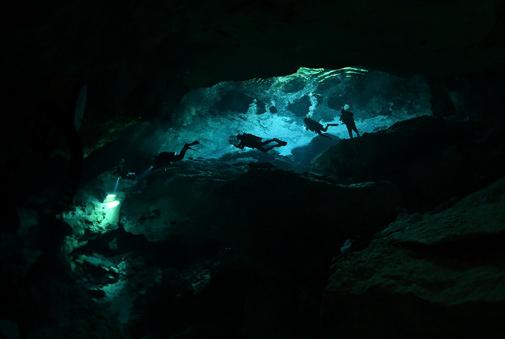
The spectacular dives of the Yucatan’s Cenotes.
For the first time on the trip, we loaded our gear into pickup trucks, climbed in and drove off. Olaf gave us his briefing on the drive.
“I used to be quite claustrophobic”, I explained. “I’m much better, but please be aware. Do you want me behind you?”
Olaf looked in his rear view mirror at me, and slowly spoke, “No, go at the back, its easy diving.”
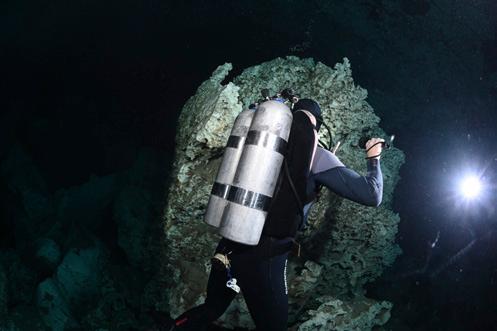
During his briefing he said, “anyone can call the dive at any time. You do not have to give me a reason. If you do, we all go out, and then the remainder go back in. But if you call the dive, you will not be doing the next one”.
Cisca piped up, “Well, at least we know we all fit through the cave systems – as long as we all simply follow you we will all fit, for sure.”
Seemingly deep in the jungle, we parked near the entry to the Cenote. These were underwater rivers linked by tunnels where sometimes the sea water ingressed.
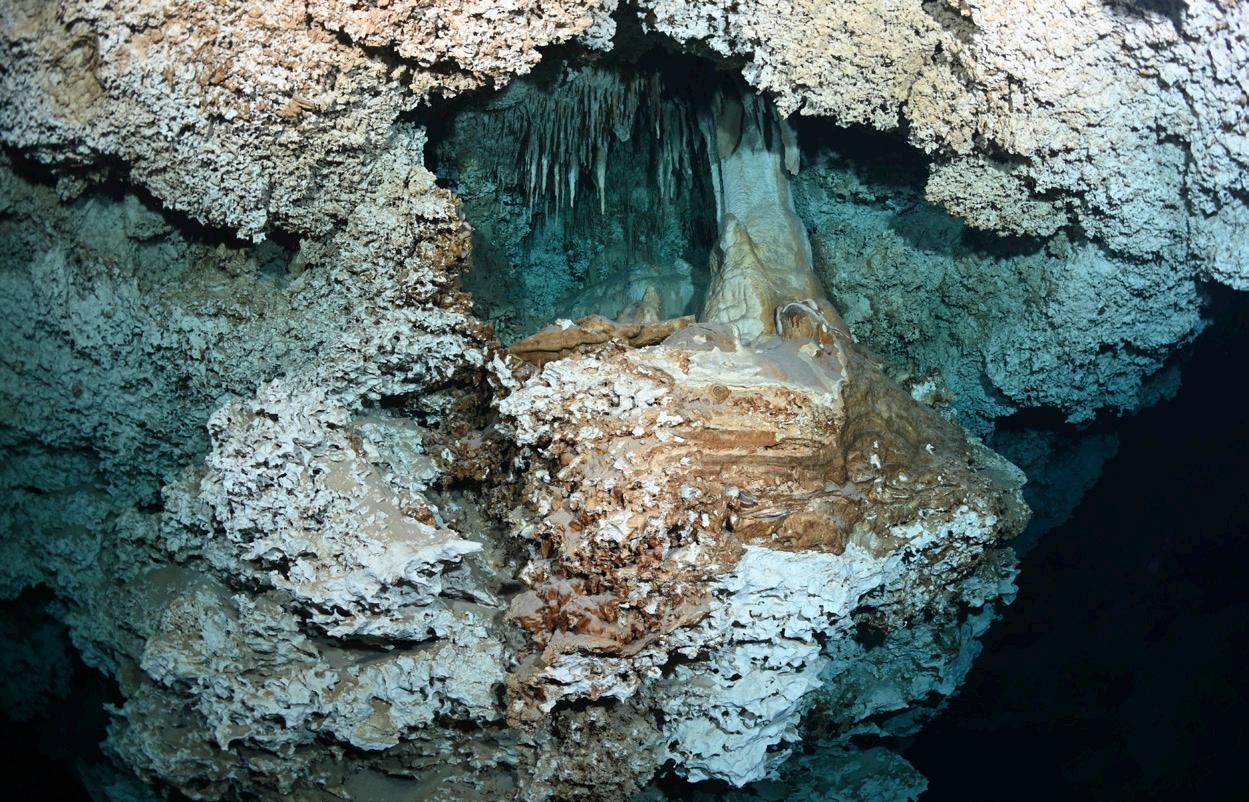
We put our equipment together and gently lowered ourselves into the water. We descended down a narrow shaft to 8m. There was absolutely no light except that which was provided by our own torches. I turned around and looked up where I could see the surface and another group of divers descending. We turned left and continued along another narrow channel, perhaps 1.5m high, and 4m wide.
Below us was the permanent line of the cavern system.This was my first time in what felt very much like a cave. I was uncomfortable, and ploughed through my air. I was determined not to end the dive and ruin it for the others, but we seemed to be going deeper and deeper into a series of tunnels. After 10 minutes, the tunnel opened up into a much larger tunnel, 5m high, and 6m wide where I could see other divers ascending to a pool in front of me. Finally, I relaxed. This was indeed not a cave dive, but a series of tunnels linking cenotes of air pockets and pools.
My previous anxiety had however taken a toll on my air. I had chewed through 33% of my gas. I tried to signal to Olaf and explain through hand signals. He calmly took us up into the cenote that I had seen from below.

“I’m fine”, I said rather embarrassedly. “I chewed through my air, but I’m fine now. My consumption has dramatically reduced though.”
“It’s no problem”, responded Olaf. “We’ll do a quick tour here, and go back’’.
I was mortified, I had reduced my buddies’ half hour dive to a mere 20 minutes, but Olaf knew what he was doing. We swam around the second cenote and he pointed out stalactites before heading back through the tunnel. We took a further 20 minutes to return, and I never finished the second third part of my air. He had read me perfectly. This was also the last problem I had in a cenote.

It is hard to describe Cenote diving. We would do one, come back, change equipment and then do another dive almost immediately. There was no significant depth to worry about decompression. No matter how much like a cave it looked, we were never more than 60 linear metres from escape. This could be 50 metres of tunnel and 10 metres to the surface, or simply 10 metres of cavern and 8 metres up. Sometimes we could see the surface, but for 90% of the dive, it felt like we were in a cave.
The diving itself was a mixture of swimming through narrow passages, where we felt we were moving from A to B, until Olaf pointed out an item of interest. Each diver would then signal the diver behind them what to look at. Then we would enter massive chambers lit up by other divers’ lights. Here we would find stalactites, a halocline, fossils caught in the rock stratae, or even catfish. Often we would see other tunnels that led into cave systems. Most cenote dives were “out and back” dives. Olaf took great care to bring us around on a different path within the larger caverns and point out different objects on the return.
“The fossils I pointed out are around 5 million years old” he said laconically after a dive.
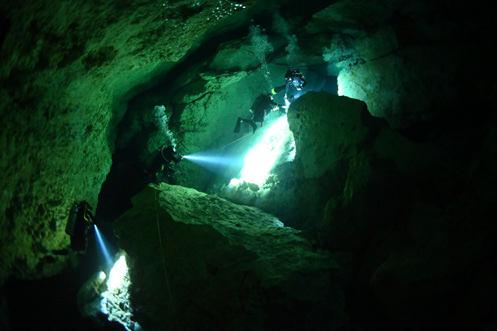
Some of the tunnels had signs saying, ‘Do not enter, danger of death.’ We were happy enough with our cavern experience and had no desire to go down them. It was made very clear to us that if anyone entered a tunnel that was not on our route, and survived, that would be their last dive with Dressel Divers. There would be no refund.
That night, Paul Flower found time in his incredibly busy schedule to have dinner with us. Francisca and I joined him and his wife Michi in a superb Argentine steak house. In Playa, the greatest issue we had was choosing from all the restaurants. Newly converted and slightly emboldened, I asked him about Cenote diving.
Paul opened up a map of our latest dive on his phone. “If you turn left at the end”, Paul pointed at the map, “you enter a cave system and you can swim almost as far as Playa.”
“But… that’s about 20km?” I said incredulously.
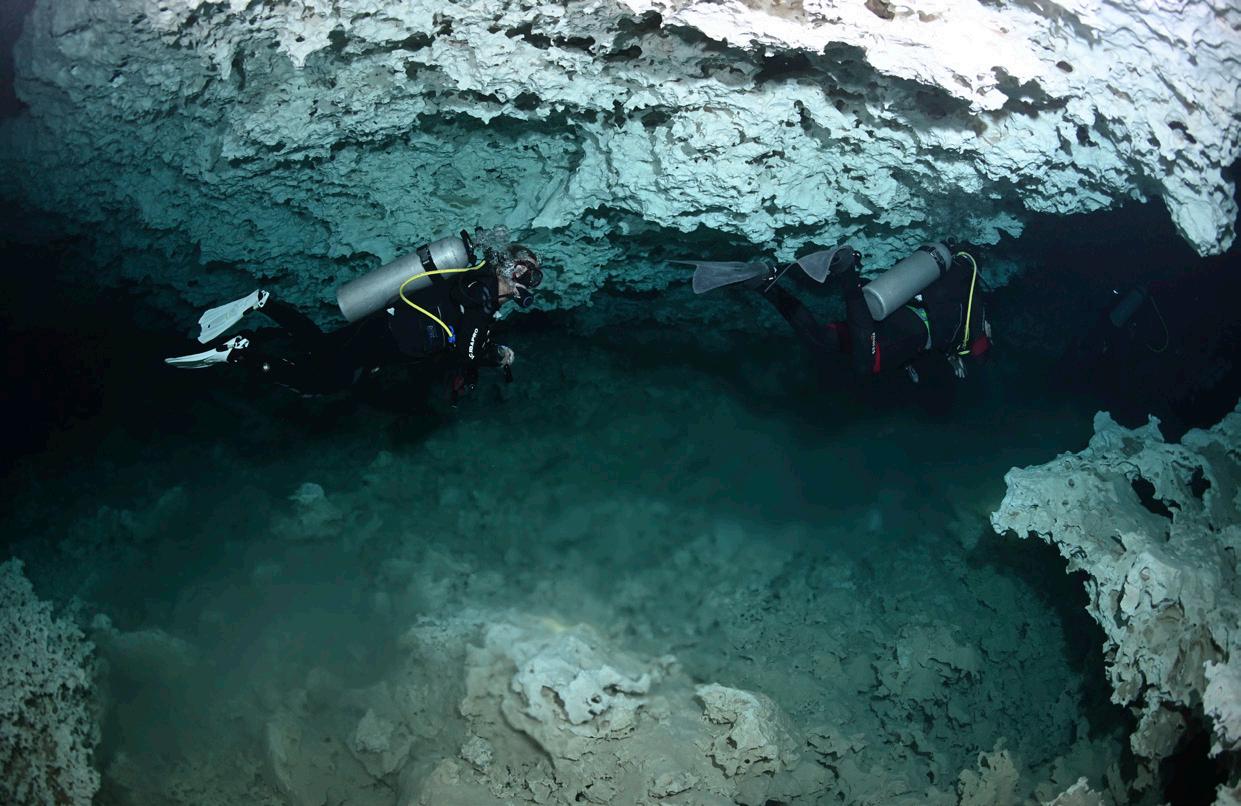
“I’ve been down that cave system following the line, and eventually my “out gas” has expired, and I’ve had to turn back.”
He paused, sipped his Malbec and thought for a while, “It’s really very hard to explain how addictive cave diving really is. Its constant exploration” he concluded.
In spite of my recent conversion, I wasn’t so sure I was convinced, but the beauty of the cave systems that even we, as recreational divers were able to access, was quite literally unbelievable.










